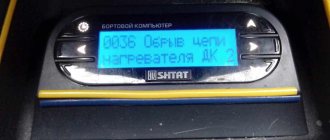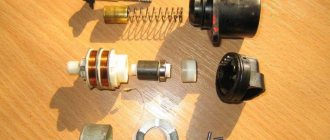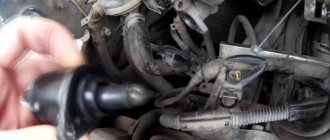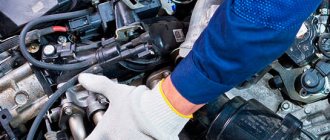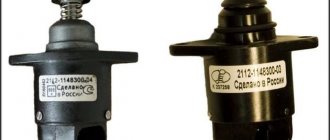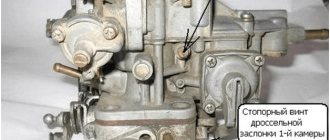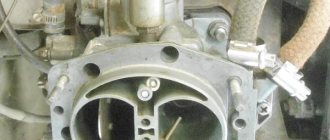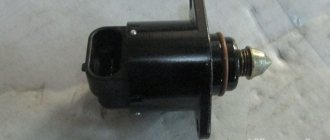Although carburetors became obsolete at the end of the twentieth century, this does not mean that carburetor cars should be written off in the twenty-first century. Although the lack of the ability to automatically maintain the composition of the air-fuel mixture diversifies the life of the owner with the need for adjustment from time to time.
A carburetor is a spray gun that sprays fuel into the air stream passing through it. In this case, the amount of fuel supplied depends on three factors:
- air flow speed;
- sections of fuel channels;
- and fuel level in the float chamber.
The faster the air flow, the greater the vacuum that draws in gasoline. The larger the section, the more it will be sucked in. Fuel supply also depends on the fuel level. Carburetor adjustments are about ensuring that these three parameters correspond to the given mixture composition. This is also the reason for the characteristic problems with idling in carburetor engines: if the mixture formation is disrupted, the engine runs intermittently, troits (the mixture is too rich or lean), stalls (gross violation of adjustments, clogged jets), does not decrease to normal (air leaks).
On automobile carburetors, the operating modes are determined by the cross-section of the diffuser and the set of jets; arbitrary adjustment is impossible there. When adjusting the carburetor, you can only change the jets. At the same time, the carburetor idle speed is adjusted using screws: the cross-section of the channels in the idle system is minimal, and even small deviations in size will greatly affect the operation of the engine. In addition, at idle, the conditions for combustion of the air-fuel mixture are worse (minimum supply of the mixture to the cylinder), which affects environmental friendliness: it is not for nothing that CO / CH are measured at idle.
Idle system design
The designs of modern carburetors contain not only the main metering system. It alone would not allow obtaining the necessary mixture composition to maintain normal engine operation in no-load mode, in other words, when the engine should be idling. The system of the same name is responsible for normal operation in idle mode. Let's consider one of the options for its design.
Design of the idle system: 1 - transition hole;
2 - air channel; 3 - idle mixture screw; 4 — hole for low idle speed; 5 - fuel channel; 6 - fuel nozzle combined with an emulsion tube. The idle system includes two fuel supply holes. They have special names: transition hole 1 and low idle speed hole 4 (location options on a real carburetor are shown in the figure below). The transition hole is located under the throttle valve, in close proximity to its trailing edge. The low idle speed hole is located behind the throttle valve, a short distance away at the point where the vacuum is greatest when the throttle valve is closed. This situation is due to the desire to ensure the easiest flow of fuel from the low idle speed hole.
Options for the location of fuel supply holes: 1 - transition hole; 2 - hole for low idle speed
In the fuel supply channel 5 of the idle system there is a nozzle 6, which limits the flow of fuel when idling. In the same channel there is an emulsion tube (often combined with a jet), in which the fuel is mixed with air entering through air channel 2.
Fine-tuning elements include screw 3, which regulates the cross-section of the air channel. In this design, the screw influences the composition of the mixture. Below we will consider a design in which a similar screw regulates the amount of mixture.
Adjustment process
Since idle speed can be increased or reduced both by the quantity and quality of the mixture, both screws must be used in the adjustment. On the Solex, the required speed is first roughly set by rotating the quantity screw. This is convenient to do, since its knurled head protrudes to the side. After this, the composition of the mixture is adjusted at the selected speed by rotating the quality screw - it is turned out while the speed increases, and you need to catch the peak, after which they begin to fall. Having caught this point, we set the idle speed to slightly increased (about 900 rpm) with the quantity screw, and then slightly tighten the quality screw clockwise, since reducing the idle speed on the carburetor to 800 rpm at the end of the setting means ensuring optimal composition of the mixture. In this way, an experienced carburetor operator will meet the CO/CH standard even without a gas analyzer, but if you immediately reset the speed with the quantity screw, the mixture will “go away”.
On Ozone, the adjustment principle is the same, although it is more difficult to control the quantity screw.
The final check of the correctness of the adjustment is carried out on the move by smoothly accelerating (to eliminate as much as possible the influence of the accelerator pump) in second gear from idle. The car should pick up speed confidently, without failure and without popping at the intake (lean mixture) or exhaust (rich mixture).
It is more convenient to adjust the idle speed using the IKS-1 device, which you can find on sale at a price of about 1,700 rubles. This is a special spark plug that allows you to observe the color of the flash flame in the cylinder through a window with quartz glass. A rich mixture has a yellow to orange flame tint, a poor mixture has a blue flame. Using the quality screw to catch the transition from one color to another, we will set the stoichiometric composition of the mixture, after which, for reliable operation at XX, it can be slightly enriched, and to save money, it can be depleted. For a carburetor engine, it is better to set a slightly enriched mixture: the dynamics are less affected by air temperature fluctuations. A lean mixture in winter, when the air density is higher, will cause problems with idle stability and worsen acceleration.
| Mixture characteristics | Air/fuel ratio | Power | Fuel consumption | Characteristic signs |
| Over-enriched | 0,6-0,8 | Drops by 20-25% | Increases by 15-25% | Black smoke, frequent popping noises in the muffler, abundant soot on the spark plugs |
| Rich | 0,8-0,9 | Maximum for this motor | Increases by 10-15% | Normal operation, good car acceleration dynamics |
| Stoichiometric (ideal) | 1,0 | Reduced by 4-5% from maximum | Increases by 4-8% | Normal operation |
| Lean | 1,05-1,15 | Reduced by 5-10% | Minimum fuel consumption | Normal operation, but dynamics deteriorate |
| Poor | 1,2-1,4 | Significantly reduced | Increases by 8-12% | Intake pops, overheating, deterioration in dynamics |
Emulsifying fuel in the idle system
In the idle system, fuel is mixed with a small amount of air, which enters through a special air channel. The fuel emulsification process occurs as follows. When the throttle valve is closed and the fuel mixture is supplied only through the low idle speed hole, the fuel is mixed with air entering not only through the air channel, but also with air from under the throttle valve passing through the transition hole. As the throttle rises, the zone of maximum vacuum moves towards the nozzle of the main dosing system. In this regard, the amount of air entering the idle system through the transition hole is reduced. At some point in the throttle lift, air completely stops flowing from the transition hole, and under the influence of rarefaction, fuel begins to gush through it. At this moment, all air begins to flow only through a special air channel, the throughput of which is regulated by a conical screw.
How to properly adjust a Solex carburetor
There are still many representatives of VAZ classics driving along the roads. Many of these cars have Solex carburetors under the hood. This carburetor is more economical and is capable of producing a higher quality mixture of fuel and air. For smooth operation of the engine, this carburetor must be properly tuned and adjusted. The class of carburetor masters is gradually dying out, so many people have to do the carburetor adjustments themselves.
Idle mixture adjustment screw
The final (fine) adjustment of the idle air system is made using a special screw with a conical tip, which regulates the throughput of the air channel of the idle air system. Some carburetor models are equipped with a screw that regulates the amount of fuel, already pre-mixed with air, supplied by the idle system.
Idle mixture adjustment screws. Two screws on the left regulate the amount of mixture, two on the right control the composition of the mixture.
Since in one case the screw regulates the composition of the mixture, and in the other - the amount of the fuel mixture, opposite adjustment methods are used. If the screw regulates the throughput of the air channel, then to enrich the mixture it is necessary to reduce the amount of air by tightening the screw. In order to make the mixture leaner, the screw must be unscrewed. If the screw regulates the amount of fuel supplied, then, on the contrary, to enrich it, it is unscrewed, and to become lean, accordingly, it is tightened.
It is very simple to understand by what principle adjustment is carried out on a particular carburetor. The air adjustment screw is located closer to the carburetor inlet, which is connected to the filter, while the fuel adjustment screw is located closer to the engine mounting flange.
Location of the idle mixture adjustment screws: a — mixture adjustment screw, b — mixture amount adjustment screw
Checking and adjusting the float chamber
Before checking and adjusting the carburetor on the VAZ 2107, you must remove the air filter along with the housing. And at the same time, check its condition, since a clogged dust filter greatly restricts air access to the engine, and this can also affect both the proportions of the working mixture and the operation of carburetor peripheral systems. Once the filter and housing are removed, unscrew the carburetor cap and gain access to most of the jets, the float chamber and the primary and secondary chamber diffusers. To begin, unscrew the plug of the filter mesh at the bottom of the lid near the fuel supply fitting. The mesh is carefully cleaned, washed, the internal cavity of the screw plug is washed, and the condition of the aluminum or bronze sealing gasket is checked.
When cleaning the internal cavities of the carburetor, you must follow important rules. Firstly, it is extremely undesirable to clean with fluffy or hard rags, since the fluff can easily clog the channels and jets. Secondly, when mechanically cleaning channels and jets, you should never use metal objects. They can irreversibly disrupt the throughput of the calibrated holes, then it will not be possible to correctly adjust the VAZ 2107 carburetor. The jets are cleaned only with wood chips, and ideally with compressed air or special cleaning liquids. The cone valve and its seat are cleaned using the same method.
Video tips for setting a stable idle
Before adjusting the fuel level in the carburetor, you need to make sure that the float is intact, has no mechanical damage and does not leak gasoline or sink in it. Otherwise, the brass float is replaced. The float is adjusted by changing the angle of the thrust tabs. The factory recommends maintaining the following clearances - with the needle valve closed, the distance from the float body to the carburetor cover gasket should be 6.5 mm. In this case, the maximum free play of the float body should be no more than 8 mm, and the distance to the gasket in the extreme position should be within 14-14.5 mm. These values are achieved by bending the persistent tabs. Check the operation of the float and cone valve by supplying gasoline with the cap installed, followed by monitoring the fuel level in the chamber.
Idle jet
If a jet of too large a capacity is installed, the engine begins to operate unstably, slowly picks up speed, and the exhaust sound becomes dull and weak.
If the jet has insufficient flow, the engine revs well, but when the throttle is closed sharply, the revs do not drop as quickly. The reduction in speed to idle occurs with a delay of up to several seconds. Too little throughput leads to unstable operation and frequent engine stops, both in low idle mode and when trying to raise the throttle. Operating the engine with an insufficient idle jet installed can result in the piston sticking to the cylinder wall when the throttle valve is closed. The risk is especially great if the engine has previously been running at full throttle for a long period of time. Under such conditions, after closing the throttle, the engine maintains high speed by inertia. If the idle system is running lean at this point, the heat load increases dramatically due to excessive lean combustion, increasing the risk of overheating and subsequent stalling.
Self-adjustment of the carburetor
As a rule, when setting up a DAAZ 2107 carburetor, car enthusiasts adjust fuel consumption and idle speed. Let's look at these stages.
Idle speed adjustment steps
Setting up the carburetor in this mode is easy:
- A carburetor with a properly adjusted idle speed allows the car engine to operate stably even with very low CO levels. To do this, the car engine warms up for 10 minutes. After this, the fuel quality screw in the carburetor is turned out as much as possible.
Operation of the idle system in transient mode
When the driver begins to open the throttle slightly, the vacuum in the area of the low idle speed hole decreases.
This leads to a decrease in the supply of fuel through it, so another system must be activated to ensure a smooth transition in operation from the idle system to the main metering system. When the throttle valve rises to approximately 1/4 of the entire stroke, the vacuum in the area of the low idle hole drops so much that the flow of fuel from it stops. The area of maximum vacuum moves closer to the nozzle of the main dosing system, but does not yet reach it. The transition hole is located exactly in this place. Fuel begins to flow out of it in an amount sufficient to ensure a smooth transition in engine operation from idle to partial load mode, when the main metering system is already operating.
Note that the idle jet is important not only for low idle operation, but also for transient operation, since it also regulates the amount of fuel flowing from the transition hole. Along with the jet, operation in transient modes is influenced by the angle of the throttle valve, a special protrusion on the rear of the throttle valve, the shape of the nozzle around the nozzle of the main metering system, and a special groove on the rear edge of the throttle valve.
Throttle valve elements affecting transient behavior. The color indicates the protrusion on the rear of the throttle body (a) and the special groove on the trailing edge (b).
To be continued…
Adjusting the carburetor draft
Before you begin adjusting the rods, you should remove the air filter cover so that nothing interferes with the process. First, using a caliper, measure the distance between the rod tips. According to factory parameters, it should be 80 millimeters. To adjust the length of the rods, you need to loosen their clamps.
Checking the strainer should be carried out when there is fuel in the float chamber. This will help you see if the shutoff valve is closing completely. After examining the valve, you need to clean and dry it. Problems with loss of power and engine failures occur due to obstructed fuel supply. This is another reason to thoroughly flush the carburetor.
The tightness of the shut-off needle can be checked using a rubber bulb, while listening for air leaks. If they are present, it is time to change the needle.
